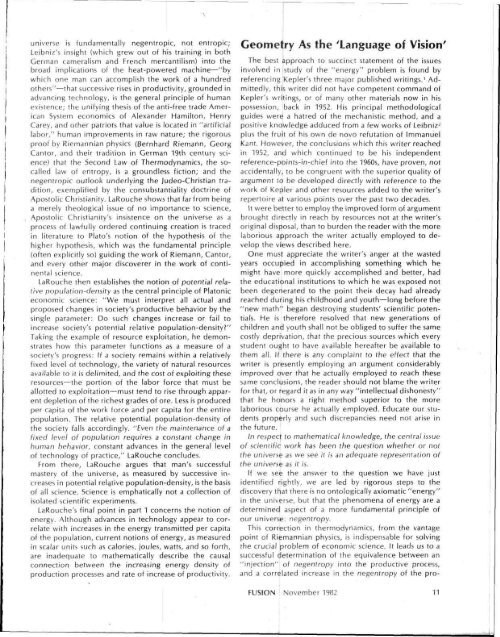Beam Weapons
Beam Weapons
Beam Weapons
Create successful ePaper yourself
Turn your PDF publications into a flip-book with our unique Google optimized e-Paper software.
universe is fundamentally negentropic, not entropic;Leibniz's insight (which grew out of hlis training in bothGerman cameralism and French mercantilism) into thebroad implications of the heat-powered machine—"bywhich one man can accomplish the work of a hundredothers"—that successive rises in productivity, grounded inadvancing technology, is the general principle of humanexistence; the unifying thesis of the anti-free trade AmericanSystem economics of Alexander Hamilton, HenryCarey, and other patriots that value is located in "artificiallabor," human improvements in raw nature; the rigorousproof by Riemannian physics (Bernhard Riemann, GeorgCantor, and their tradition in German 19th century science)that the Second Law of Thermodynamics, the socalledlaw of entropy, is a groundless fiction; and thenegentropic outlook underlying the Judeo-Christian tradition,exemplified by the consubstantiality doctrine ofApostolic Christianity. LaRouche shows that far from beinga merely theological issue of no importance to science,Apostolic Christianity's insistence on the universe as aprocess of lawfully ordered continuing creation is tracedin literature to Plato's notion of the hypothesis of thehigher hypothesis, which was the fundamental principle(often explicitly so) guiding the work of Riemann, Cantor,and every other major discoverer in the work of continentalscience.LaRouche then establishes the notion of potential relativepopulation-density as the central principle of Platoniceconomic science: "We must interpret all actual andproposed changes in society's productive behavior by thesingle parameter: Do such changes increase or fail toincrease society's potential relative population-density?"Taking the example of resource exploitation, he demonstrateshow this parameter functions as a measure of asociety's progress: If a society remains within a relativelyfixed level of technology, the variety of natural resourcesavailable to it is delimited, and the cost of exploiting theseresources—the portion of the labor force that must beallotted to exploitation—must tend to rise through apparentdepletion of the richest grades of ore. Less is producedper capita of the work force and per capita for the entirepopulation. The relative potential population-density ofthe society falls accordingly. "Even the maintenance of afixed level of population requires a constant change inhuman behavior, constant advances in the general levelof technology of practice," LaRouche concludes.From there, LaRouche argues that man's successfulmastery of the universe, as measured by successive increasesin potential relative population-density, is the basisof all science. Science is emphatically not a collection ofisolated scientific experiments.LaRouche's final point in part 1 concerns the notion ofenergy. Although advances in technology appear to correlatewith increases in the energy transmitted per capitaof the population, current notions of energy, as measuredin scalar units such as calories, joules, watts, and so forth,are inadequate to mathematically describe the causa)connection between the increasing energy density ofproduction processes and rate of increase of productivity.Geometry As the "Language of Vision'The best approach to succinct statement of the issuesinvolved in study of the "energy" problem is found byreferencing Kepler's three major published writings. 1 Admittedly,this writer did not have competent command ofKepler's writings, or of many other materials now in hispossession, back in 1952. His principal methodologicalguides were a hatred of the mechanistic method, and apositive knowledge adduced from a few works of Leibniz 2plus the fruit of his own de novo refutation of ImmanuelKant. However, the conclusions which this writer reachedin 1952, and which continued to be his independentreference-points-in-chief into the 1960s, have proven, notaccidentally, to be congruent with the superior quality ofargument to be developed directly with reference to thework of Kepler and other resources added to the writer'srepertoire at various points over the past two decades.It were better to employ the improved form of argumentbrought directly in reach by resources not at the writer'soriginal disposal, than to burden the reader with the morelaborious approach the writer actually employed to developthe views described here.One must appreciate the writer's anger at the wastedyears occupied in accomplishing something which hemight have more quickly accomplished and better, hadthe educational institutions to which he was exposed notbeen degenerated to the point their- decay had alreadyreached during his childhood and youth—long before the"new math" began destroying students' scientific potentials.He is therefore resolved that new generations ofchildren and youth shall not be obliged to suffer the samecostly deprivation, that the precious sources which everystudent ought to have available hereafter be available tothem all. If there is any complaint to the effect that thewriter is presently employing an argument considerablyimproved over that he actually employed to reach thesesame conclusions, the reader should not blame the writerfor that, or regard it as in any way "intellectual dishonesty"that he honors a right method superior to the morelaborious course he actually employed. Educate our studentsproperly and such discrepancies need not arise inthe future.In respect to mathematical knowledge, the central issueof scientific work has been the question whether or notthe universe as we see it is an adequate representation ofthe universe as it is.If we see the answer to the question we have justidentified rightly, we are led by rigorous steps to thediscovery that there is no ontologically axiomatic "energy"in the universe, but that the phenomena of energy are adetermined aspect of a more fundamental principle ofour universe: negentropy.This correction in thermodynamics, from the vantagepoint of Riemannian physics, is indispensable for solvingthe crucial problem of economic science. It leads us to asuccessful determination of the equivalence between an"injection" of negentropy into the productive process,and a correlated increase in the negentropy of the pro-FUSION November 1982 11
















